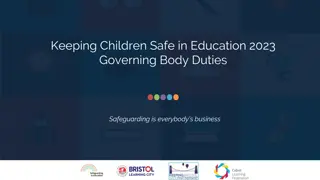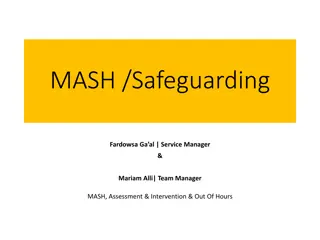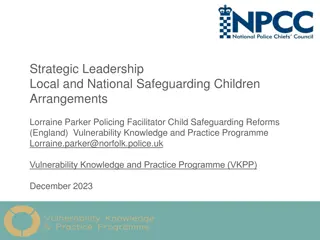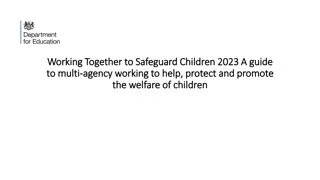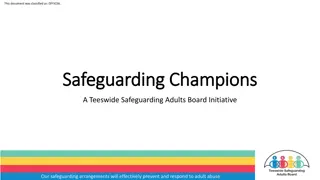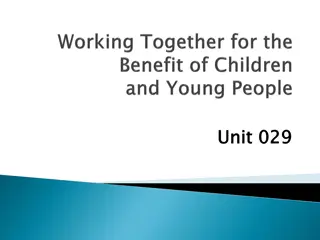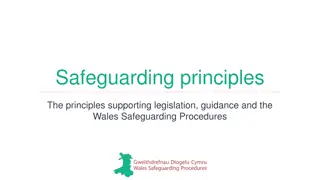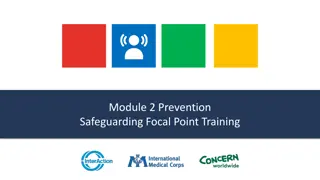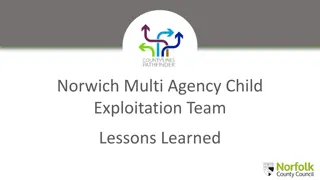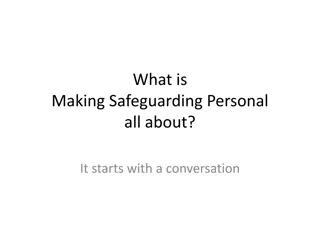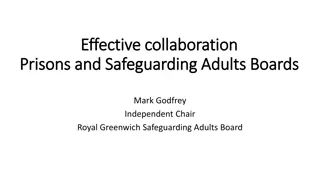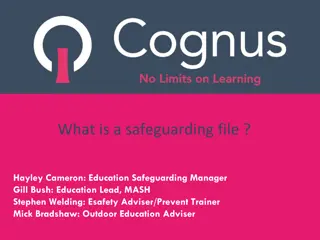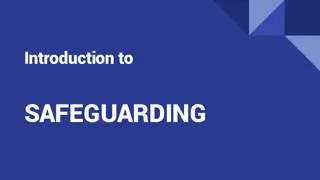Understanding Contextual Safeguarding in Multi-Agency Working
This workshop aims to assist multi-agency practitioners in developing Contextual Safeguarding approaches through team activities and discussions. The session covers partnership working outside the home, the ecological approach of Contextual Safeguarding, and an exercise on creating safety in various scenarios. Participants will reflect on how to work collaboratively to create safer contexts beyond the home where harm may occur.
Download Presentation

Please find below an Image/Link to download the presentation.
The content on the website is provided AS IS for your information and personal use only. It may not be sold, licensed, or shared on other websites without obtaining consent from the author. Download presentation by click this link. If you encounter any issues during the download, it is possible that the publisher has removed the file from their server.
E N D
Presentation Transcript
Before you begin Key to logos This workshop is to help multi-agency practitioners who are developing Contextual Safeguarding approaches to reflect on what this means for multi-agency working. Read this slide out to the group It is designed to be a team activity. It can be used in a multi-agency setting or by single agencies reflecting on how they interact with their partners. It should last 45-60 minutes. This is an activity We recommend that you nominate 1-2 facilitators. Before they begin it is helpful that they read the supporting briefing. The estimated time needed for each slide is listed in the bottom left corner. Discussion Each slide has a logo that explains to the facilitator what to do. Instructions for the facilitator are listed in the bar at the bottom of the slide. This is where instructions for the facilitator are. 1 minute
This workshop includes 1. A quick introduction to Contextual Safeguarding and partnership working 2. An exercise on 'behaviour-based' approaches and 'ecological approaches 3. A group activity to think about the approaches used in different services/partnerships 4. Space to develop action points for yourself, your team/meeting and your wider organisation 1 minute
Partnership working outside the home When children experience harm outside their families (extra-familial harm) social workers are being asked to provide welfare/safeguarding responses Working outside the home is relatively new for social work, but is common for partners like the police and youth workers It makes sense that partners work together There has been a drive to strengthen multi-agency working over recent years especially following serious case reviews 1 minute
Contextual Safeguarding is an ecological approach Contextual Safeguarding is a response to extra-familial harm that asks practitioners to work in partnership Contextual Safeguarding responses involve partners working together to create safer contexts beyond the home, where the harm is (i.e. in a school, a park or online) Contextual Safeguarding asks workers to change the social conditions of harm and abuse in these contexts, which makes it an ecological approach Typically, interventions into extra-familial harm tend to try to change the behaviour of individuals affected, not the environment and so Contextual Safeguarding is different from usual practice 1 minute
'Creating safety' exercise Scenario: A 17 year old girl is walking home at night at 11pm. She s texting her friend as she s walking home. She chooses a shortcut down a dark alley. What could make her safer? 1. Getting a taxi home instead of walking 2. Carrying a rape alarm 3. Increasing youth workers in the area 4. Increasing the lighting on the route 5. Not wearing headphones 6. A local campaign to promote residents and businesses looking out for people out late at night and checking if they are ok 7. Not going out 8. Walking home with her friends 9. Encouraging her to dress in a way that won't get attention 10. A campaign that educates people not to harass women 11. Drinking in moderation Read the scenario to the group. Give everyone 1 minute alone to choose the top three approaches they think will keep the girl safest. Try not to overthink it. 2 minutes
Is it behaviour-based or is it ecological? Some of these approaches are more about changing the behaviour (of the young person at risk of being harmed) and some are more about changing the environment or context around them to reduce the chances of the harm happening (an ecological approach). Behaviour-based 1. Getting a taxi home instead of walking 2. Carrying a rape alarm 5. Not wearing headphones 7. Not going out 8. Walking home with her friends Ecological 3. Increasing youth workers in the area 4. Increasing the lighting on the route 6. A local campaign to promote residents 8. Walking home with her friends 10. A campaign about harassment 9. Encouraging her to dress 11. Drinking in moderation What are some of the challenges/positives of the different approaches? Read the introduction. Before revealing the list , ask people to discuss what they chose. Look back at the exercise and name which you think are behaviour-based and which are ecological. Discuss the question in bold as a group. 10 minutes
What's behind these different approaches? It's about whether we see social problems as mostly a result of the environment or mostly a result of choices that individuals make It's about whether we believe people have equal choices to decide what happens to them, or if this is decided and shaped by their environment You might think it s a bit of both (e.g. people make choices but are influenced by their environment). But you might lean more towards one option depending on different things like the person's age, what is happening to them or what their environment is like For example, you might think an 8 year old would be exploited to carry drugs but a 17 year old may be making a choice When partnerships intervene to safeguard young people from extra-familial harm, they tend to focus more on the choices teenagers have rather than on changing their environments (Owens & Lloyd, 2023) 3 minutes
In summary Ecological approaches: Approaches that try to change the environment, context or structure around a person Behaviour-based: Approaches that try to change the behaviour of an individual person through rewards, punishments or changing beliefs An example A young person gets caught carrying a knife, they say they carried it because they feel unsafe walking home from school. A behaviour-based approach might try to change their behaviour by helping them to choose not to carry a knife (e.g., through a weapons awareness programme). An ecological approach might try to understand why they felt unsafe and make it safer (e.g., through increasing safe adults on the route home). 4 minutes
What's the problem? If you use a mix of approaches and know why you do it, it might not be a problem The problem is that behaviour-based approaches dominate services (like education, police, social care and youth offending) This means most of us are not aware that we are choosing behaviour-based approaches instead of ecological ones Even if we are aware and want to work ecologically, when one approach dominates, it's hard to do something differently Contextual Safeguarding is an ecological approach If we want to use Contextual Safeguarding it is important to use ecological ways to develop approaches that try to change the environment so that they are safer rather than only trying to change their behaviour 3 minutes
Going deeper exercise Next are exercises to help you reflect on your service/partnership's use of ecological and behaviour-based approaches This is about starting to understand on what basis your service/partnership uses the two approaches (i.e. based on what is driving harm in a context or based on young people's ages, type of harm or other circumstances) It's also about becoming aware of how some agencies might draw on behaviour-based or ecological approaches differently and how this influences the overall work of your team/service/partnership As you do this exercise, keep a note of what makes it hard to have these types of conversations (time, space, culture, power etc.) 2 minutes
Introducing the exercises The next slides outline different sets of questions to think about. Before you begin, decide which slides to use. There are four options: 1. Multi agency meetings and panels to explore issues that arise in meetings or panel. 2. Multi agency teams or working to explore issues that are relevant to multi-agency teams or joint work. 3. Extra-familial harm questions for those wanting to explore in more depth how these issues relate to different forms of risk and harm 4. Senior leaders questions to help senior leaders think about what this means at a strategic level This exercise asks participants to be honest about their experiences of multi-agency working. In the light of this, arrange people into smaller groups with people they trust. Consider how you can help people feel emotionally safe to reflect critically. Tell groups that they have 20 minutes for discussion and 10 minutes to feedback before moving on to the next steps slide. There are two slides of questions for each set. 20 minutes discussion and 10 minutes feedback
Multi-agency meetings/panels Group Exercise
Who's in your meeting? 1. List all the agencies/organisations who attend your meeting/panel 2. Go through each one and talk about how much you think their professional training focusses on behaviour-based or ecological ways of understanding problems and responding 3. Who has the most expertise or ability to think and work ecologically in your meeting? Why? Whose voice counts? 1. Think about your last meeting which agencies spoke the most? Who spoke the least (or was completely absent)? 2. If there is a disagreement in a meeting, how do you decide what to go for? Is it agencies/people with expertise in ecological approaches, or not? Why not? 3. Try reflect honestly on how the following factors influence who speaks and who influences decisions in your meetings: if someone is wearing uniform; if their agency is used to working outside the home; their gender; a person's job title. Anything else you would add to this list? Continued.... Encourage participants to think of a specific meeting when they discuss the questions i.e. the MACE panel
What's the culture like? 1. Think about what it's like to be in the meetings - is it ok to be unsure or not know what the answer is to a problem? If not, why not? 2. Can you question each other and consider alternatives? 3. Think about when you disagreed with someone in a meeting (it might have just been that you disagreed in your head not out loud). How did that feel? Could you share your disagreement? What does that tell you about the atmosphere and culture of the meeting? What needs to change? 1. What could help the you (as a group) understand whether a behaviour-based or ecological approach is needed in a particular situation? 2. Could you adapt any of your current assessments, plans and responses to make them more ecological? What would you need to do? 3. Who can help you make sure ecological responses happen (i.e. talk to commissioners)?
Multi-agency teams/ co-working Group Exercise
Who's in your team/partnership? 1. List all the agencies/organisations in your team/co-working situation 2. Go through each one and talk about how much you think their professional training focusses on behaviour-based or ecological ways of understanding problems and responding 3. Who do you think has the most expertise in working ecologically in your team or co/working situation? Whose voice counts? 1. In your team, which agencies have the most influence? 2. Are those with expertise in ecological approaches given priority or not? 3. Try reflect honestly on whether the following factors impact relationships between agencies and who has most influence in your team: if someone is wearing uniform; if their agency is used to working outside the home; their gender; a person's job title. Anything else you would add to this list? Continued.... Encourage participants to think of a recent example of multi-agency joint work
What does your work involve? 1. Write down some responses young people receive from your team/co-working partnership 2. Think about whether each one targets the behaviour of young people or tries to change the environment or context 3. Focus on one behaviour-based response. Try to think about the beliefs that underpin this approach. Do you agree with this belief? What would others in your team say? What do you think young people would think about it? As an example: a 'knife carrying awareness programme' is based on a belief that if young people are more aware of the dangers of knife carrying, they will choose not to do it. What needs to change? 1. What could help your team understand whether a behaviour-based or ecological approach is needed? 2. How could you adapt your current assessments, plans and responses to make them more ecological? 3. Who can help you make sure ecological responses happen (i.e. talk to commissioners)?
Extra-familial harm Group Exercise
Who's in your partnership? 1. List all the agencies/organisations in your partnership 2. Go through each one and talk about how much you think their professional training focusses on behaviour-based or ecological ways of understanding problems and responding 3. Who do you think has the most expertise in working ecologically in your team or co/working situation? Whose voice counts? 1. In your partnership, which agencies have the most influence? Which responses are thought of as most 'robust'? 2. Are those with expertise in ecological approaches given priority or not? 3. Try reflect honestly on how the following factors impact relationships between agencies and who has most influence in your partnership: if someone is wearing uniform; if their agency is used to working outside the home; their gender; a person's job title. Anything else you would add to this list? Continued.... Encourage participants to think of a specific recent example of partnership working
What type or risk are you working with? 1. List the main types of risk and harm that your partnership responds to? 2. Think about whether you tend to deal with high-risk situations or those at the lower end of the spectrum of harm 3. Which harm types (e.g. CSE) and levels of risk (e.g. significant) tend to get traditional responses? Which harm types and levels of risk are more likely to get creative / newer types responses? Why is this? Do you get what you need? 1. Where do people in your partnership share and think about the worries (and other feelings) that come with responding to harm outside the home? 2. Do you have the support of the wider organisation to try new and creative responses to extra-familial harm? 3. What would help your partnership be able to develop ecological responses?
Senior leaders Group exercise
Who's in your partnership? 1. List all the agencies/organisations in the multi-agency partnership 2. Go through each one and talk about how much you think their professional training focusses on behaviour-based or ecological ways of understanding problems and responding 3. Who do you think has the most expertise in working ecologically in the teams, meetings and co/working situations that you oversee? Whose voice counts? 1. In your partnership, which agencies have the most influence? 2. Are those with expertise in ecological approaches given priority or not? 3. Try reflect honestly on whether the following factors impact relationships between agencies and who has most influence in your partnerships: if someone is wearing uniform; if their agency is used to working outside the home; their gender; a person's job title. Anything else you would add to this list? Continued.... Encourage participants to think of a recent and specific example of multi-agency partnership joint work
Where are your commissioning priorities? 1. Do you commission services that prioritise behaviour-based methods or those that work ecologically? 2. What frameworks can you develop for measuring changes to the social conditions of harm as well as individual child level measurements? 3. When you commissioning ecological responses, will (or do) you allow for the fact that these are much newer than behaviour-based responses? (i.e. they take longer, likely cost more, create anxiety etc.) What system change is needed? 1. How can you develop a culture where practitioners and managers are free to try new things? 2. What's getting in the way? 3. Who else in your organisation can help with this?
Next steps You What is the main thing that you have learnt from this training? Write a short reflection and then three action points Your team/meeting How can your team/meeting develop a shared vision for how you respond to extra-familial harm in the light of what you have learnt? Plan a time soon to discuss this together and come up with three action points. Remember to build in critical reflection into your plan. Your organisation What can your organisation do to help you to develop multi-agency work? This could be reducing pressures that can create defensive practice or providing support and encouragement that supports openness and reflection. Who can you feed this back to and how? 5 minutes
We hope this workshop was useful, for feedback please contact rachael.owens@durham.ac.uk This workshop was developed by Rachael Owens and Jenny Lloyd as part of their research. For more resources and to read the research please visit the Contextual Safeguarding website.



